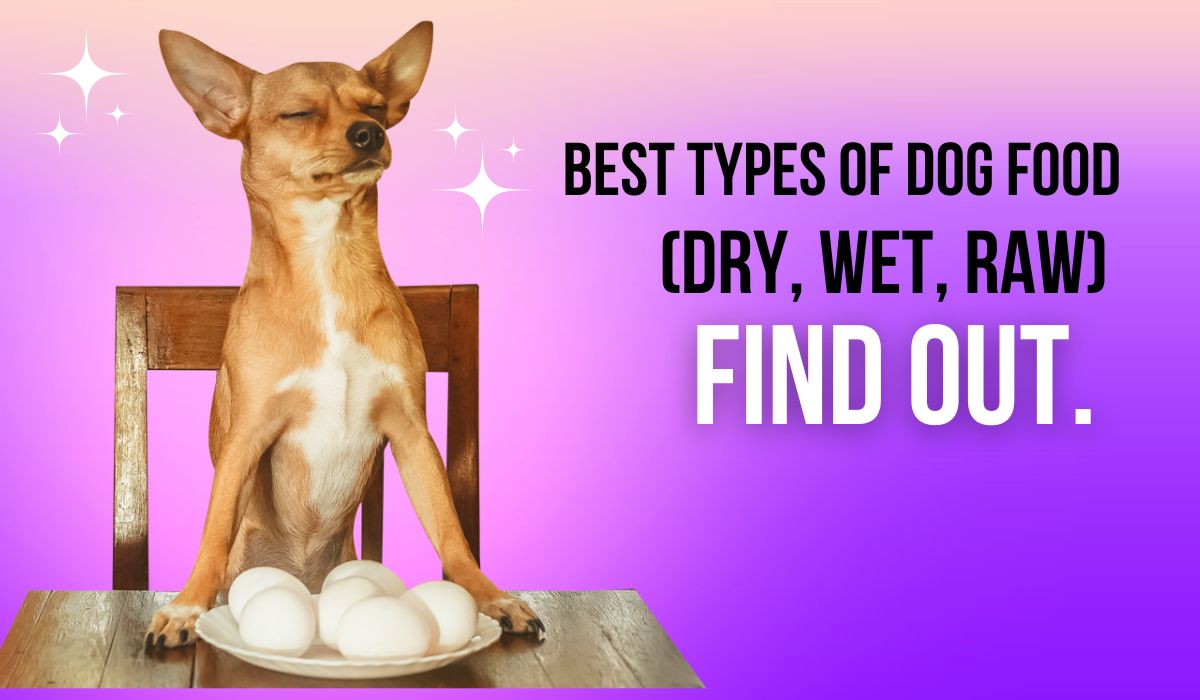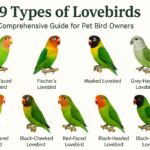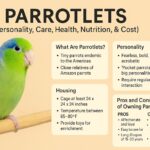Choosing the right dog food is a crucial decision for pet owners. With so many options available, it can be overwhelming to determine what’s best for your furry friend. The main types of dog food are dry kibble, wet food, and raw diets. Each has its own pros and cons when it comes to nutrition, convenience, and cost. Dry food is popular for its long shelf life and dental benefits, while wet food offers higher moisture content and palatability.
Raw diets have gained traction recently, with proponents claiming they mimic a dog’s ancestral diet. A 2018 study found that raw diets increased gut bacteria diversity in dogs, though they also boosted levels of potentially harmful E. coli. Ultimately, the best choice depends on your dog’s individual needs, health status, and preferences. Consulting with your vet can help you make an informed decision to keep your pup happy and healthy.
Dry Dog Food (Kibble)
Dry dog food, also known as kibble, is a popular choice for many pet owners. Let’s dive into what makes this type of chow special and how it’s made.
What’s Kibble and How’s It Made?
Kibble is dog food that comes in small, dry pieces. It’s made by mixing dry and wet ingredients to form a dough. This dough is then cooked under pressure and pushed through a machine with small holes. As it comes out, it’s cut into bite-sized pieces. These pieces are then dried, cooled, and coated with flavors and vitamins. The ingredients in kibble can include:
- Meat or fish
- Grains like rice or corn
- Vegetables
- Vitamins and minerals
What’s in Kibble?
Kibble packs a nutritional punch. It’s designed to give dogs all the nutrients they need in one meal. Here’s what you’ll typically find in dry dog food:
- Protein: At least 18% for adult dogs and 22% for puppies
- Fat: About 5-15%
- Carbohydrates: Around 30-70%
- Fiber: About 2-4%
- Vitamins and minerals: Including vitamins D, E, and B-complex
Why Folks Love Kibble
Kibble has some cool perks that make it a top pick for many dog owners:
- Easy to Store: You can keep kibble in a dry place for up to a year if it’s unopened. Once opened, it stays fresh for about 6 weeks in an airtight container.
- Good for Teeth: Crunchy kibble can help scrape plaque off your pup’s teeth. This might mean fewer trips to the doggy dentist.
- Wallet-Friendly: Compared to wet or fresh dog food, kibble often costs less.
- Fun for Dogs: You can use kibble in food puzzles or slow feeders. This gives your dog a fun challenge and helps them eat slower.
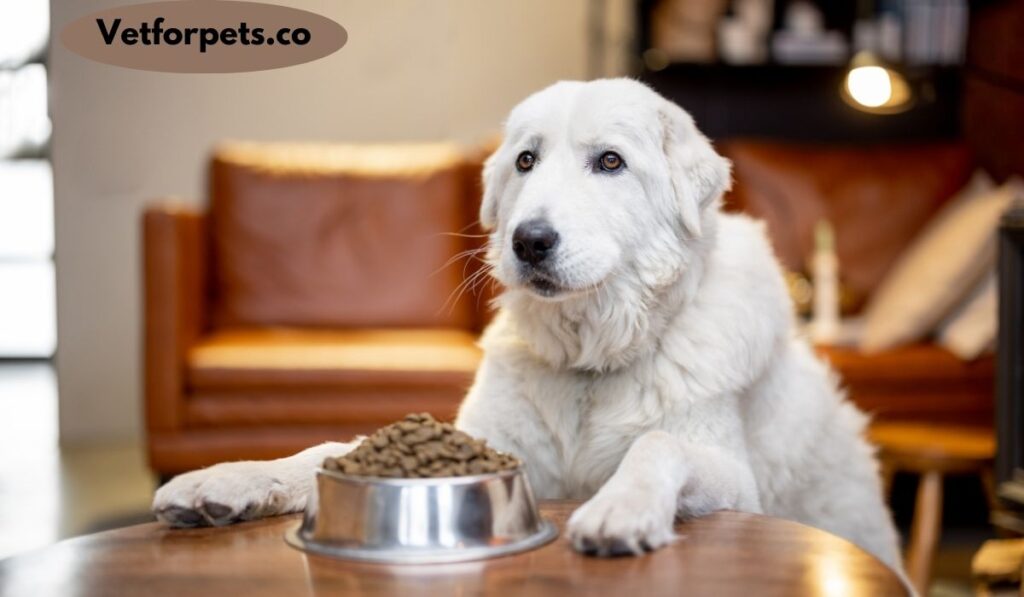
Things to Watch Out For
While kibble is great, there are a few things to keep in mind:
- Not Much Water: Kibble only has about 10% moisture. This means your dog needs to drink more water when eating dry food.
- Easy to Overeat: Some dogs might eat too much kibble if you’re not careful. It’s important to measure out the right amount.
Cool Kibble Facts
Did you know that kibble was invented in 1860? A guy named James Spratt made the first dog biscuits after seeing sailors feed hardtack to dogs. His recipe included wheat, vegetables, and beef blood. Today, about 95% of dog owners in the U.S. feed their pups dry food. That’s a lot of kibble!
Picking the Right Kibble
When choosing kibble for your furry friend, look for these things:
- A protein source (like chicken or beef) as the first ingredient
- No artificial colors or flavors
- A statement saying it meets AAFCO standards
Remember, every dog is different. What works for one pup might not be best for another. It’s always a good idea to chat with your vet about the best food for your dog.
Kibble Hacks
Here are some fun ways to make kibble even better:
- Add water: Soaking kibble in warm water for 15-20 minutes can make it easier to eat, especially for older dogs.
- Mix it up: Try adding some wet food or fresh veggies to your dog’s kibble for extra flavor and nutrients.
- Use it for training: Kibble can make great treats during training sessions.
Wet Dog Food
Let’s dive into the world of wet dog food and see why it might be a great choice for your furry friend!
What is Wet Dog Food?
Wet dog food is like a yummy stew for your pup. It comes in cans, pouches, or trays and has a lot more water than dry kibble. This food is cooked right in its container, which keeps it fresh and tasty for your dog.
How It’s Made
Making wet dog food is kind of like cooking a big batch of soup. Here’s how it goes:
- Mix the ingredients: Meat, veggies, and other good stuff are mixed together.
- Fill the containers: The mix is put into cans, pouches, or trays.
- Seal it up: The containers are closed tight to keep out germs.
- Cook it: Everything is heated up to kill any bad bacteria.
- Cool it down: The food is cooled and ready to be shipped.
This process keeps the food safe and yummy for your pup.
What’s in Wet Dog Food?
Wet dog food is packed with good stuff for your dog. Here’s what you’ll usually find:
- Protein: About 8-12%
- Fat: Around 5-8%
- Carbs: Not too much, usually less than 30%
- Water: A lot! About 70-80%
- Vitamins and Minerals: All the good stuff your dog needs to stay healthy
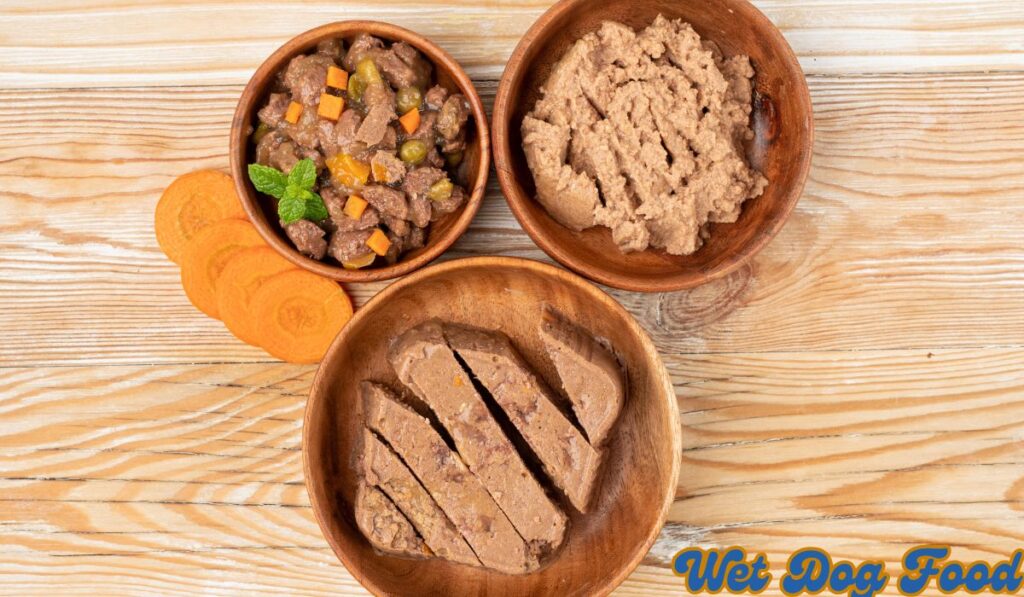
Why Wet Food is Awesome
1. It’s Super Moist
Wet dog food has a lot of water in it. This is great for dogs who don’t drink enough water on their own. It helps keep them hydrated and feeling good.
2. Smells and Tastes Great
Dogs love the smell and taste of wet food. It’s like a yummy treat at every meal! This can be super helpful if your dog is a picky eater.
3. Easy to Eat
If your dog has trouble chewing, wet food can be a lifesaver. It’s soft and easy to eat, which is great for older dogs or pups with dental issues.
4. Helps with Weight Control
The extra water in wet food can make your dog feel full without eating too many calories. This can be helpful if your pup needs to lose a few pounds.
Things to Watch Out For
1. It Doesn’t Last Long
Once you open a can of wet food, it needs to be eaten pretty quickly. It usually only lasts about 3-5 days in the fridge.
2. Might Not Be Great for Teeth
Some vets worry that wet food might not be as good for dogs’ teeth as crunchy kibble. But don’t worry! You can help keep your dog’s teeth clean by brushing them or giving them dental chews.
Fun Fact Time!
Did you know that wet dog food has been around for over 100 years? The first canned dog food was made in 1922 by the Chappel brothers in England. They made it because there were too many horses after World War I, and they needed a way to use the extra horse meat. Weird, right?
What the Experts Say
Scientists have done some cool studies on wet dog food. One study found that dogs who ate wet food had different bacteria in their mouths compared to dogs who ate dry food. The wet food dogs had more of the good bacteria that help keep mouths healthy.
Another study looked at how well dogs digested wet food compared to dry food. They found that wet food was easier for dogs to digest, which means they get more of the good stuff from their food.
Choosing the Right Wet Food
When picking out wet food for your pup, look for these things:
- A protein (like chicken or beef) is the first ingredient
- No artificial colors or flavors
- Added vitamins and minerals
- A statement saying it meets AAFCO standards
Remember, every dog is different. What works for one pup might not be best for another. It’s always a good idea to chat with your vet about the best food for your dog.
Wet Food Hacks
Here are some fun ways to use wet food:
- Mix it up: Try adding a spoonful of wet food to your dog’s dry kibble for extra flavor.
- Freeze it: Put some wet food in a Kong toy and freeze it for a cool summer treat.
- Use it for training: Small bits of wet food can make great high-value treats during training sessions.
Raw Dog Food
Let’s dive into the world of raw dog food and see what all the fuss is about!
What is Raw Dog Food?
Raw dog food is exactly what it sounds like – food for dogs that isn’t cooked. It’s meant to be like what dogs would eat in the wild. There are two main types:
- Homemade raw diets: This is when pet parents make the food themselves using raw ingredients.
- Commercial raw diets: These are pre-made raw foods you can buy at the store.
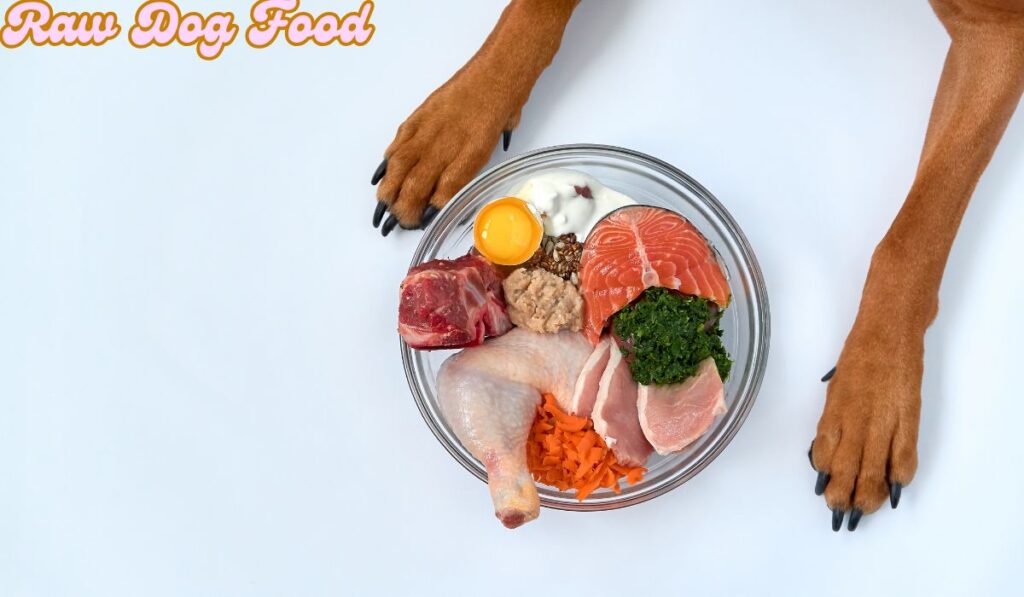
Homemade Raw Diets
When making raw food at home, pet parents usually include:
- Raw meat (like chicken, beef, or lamb)
- Raw bones
- Organ meats (like liver or kidney)
- Fruits and veggies
- Sometimes eggs or dairy
This type of diet is often called BARF (Biologically Appropriate Raw Food). Sounds gross, but dogs love it!
Commercial Raw Diets
You can find these at pet stores or online. They come in different forms:
- Frozen raw food
- Freeze-dried raw food
- Dehydrated raw food
Some brands even use a special process called High-Pressure Pasteurization (HPP) to kill bad bacteria without cooking the food.
What’s in Raw Dog Food?
Raw dog food is packed with good stuff for your pup. Here’s what you’ll usually find:
- Protein: About 70% of the diet
- Fat: Around 10-20%
- Bones: About 10%
- Organs: About 5-10%
- Fruits and Veggies: About 5-10%
This mix is meant to copy what dogs would eat in the wild. It’s important to get the balance right to keep your pup healthy.
The Good Stuff About Raw Dog Food
Many pet parents swear by raw diets. Here’s why:
1. It’s Like What Dogs Ate Way Back When
Raw diets are meant to be like what dogs’ wild ancestors ate. Some folks think this is better for dogs because it’s more natural.
2. It Might Help with Digestion
Some pet parents say their dogs have better poops on a raw diet. A study in 2018 found that raw diets can increase good bacteria in dogs’ guts.
3. Shiny Coats and Healthy Skin
Many dogs on raw diets have super shiny coats. This might be because raw diets are often high in good fats.
4. More Energy
Some pet parents say their dogs have more pep in their step on a raw diet.
5. Cleaner Teeth
Chewing on raw bones can help keep dogs’ teeth clean. A study found that chewing raw bones can reduce dental gunk by up to 87.8%.
Things to Think About
While raw diets sound great, there are some things to watch out for:
1. Safety First!
Raw meat can have nasty bacteria like Salmonella or E. coli. These can make both dogs and humans sick. A study found that nearly 60% of raw diets tested had these bad bugs. To stay safe:
- Wash your hands after handling raw food
- Clean all surfaces and bowls that touch the raw food
- Keep raw food separate from other foods
- Don’t let your dog lick your face after eating raw food
2. Getting the Balance Right
It’s tricky to make sure homemade raw diets have all the nutrients dogs need. A study found that 95% of homemade raw diets were missing important nutrients. If you’re going the homemade route, it’s a good idea to talk to a vet nutritionist to make sure your pup is getting everything they need.
3. It Can Be Pricey
Raw diets, especially commercial ones, can cost more than regular dog food. For example, a 6-pound bag of freeze-dried raw food can cost around $30-$40, while a 30-pound bag of kibble might cost $40-$50.
4. It Takes Time
Making raw food at home takes time and effort. You need to:
- Buy the ingredients
- Prepare the food
- Store it properly
- Clean up carefully
What the Experts Say
The American Veterinary Medical Association (AVMA) doesn’t recommend raw diets because of the safety risks. But some vets are okay with raw diets if they’re done right.
Comparing Dog Food Types
Let’s dive into the world of dog food and compare the different types: dry, wet, and raw. We’ll look at how they stack up in terms of nutrition, moisture, cost, and convenience.
Nutritional Differences
When it comes to keeping your furry friend healthy, what’s in their bowl matters a lot. Let’s break down the nutritional differences between the three main types of dog food.
Dry Dog Food (Kibble)
Dry dog food typically contains:
- Protein: At least 18% for adult dogs and 22% for puppies
- Fat: About 5-15%
- Carbohydrates: Around 30-70%
- Fiber: About 2-4%
- Vitamins and minerals: Including vitamins D, E, and B-complex
Kibble is cooked at high temperatures, which can affect some nutrients. But it’s also often fortified with extra vitamins and minerals to make up for this.
Wet Dog Food
Wet dog food usually has:
- Protein: About 8-12%
- Fat: Around 5-8%
- Carbohydrates: Usually less than 30%
- Vitamins and minerals: Similar to dry food, but in different amounts
Wet food often has more protein and fat than dry food, which can be great for active dogs.
Raw Dog Food
Raw diets typically include:
- Protein: About 70% of the diet
- Fat: Around 10-20%
- Bones: About 10%
- Organs: About 5-10%
- Fruits and veggies: About 5-10%
Raw food fans say it’s closest to what dogs would eat in the wild. But it’s important to make sure it’s balanced with all the nutrients your pup needs.
Moisture Content Comparison
The amount of water in your dog’s food can make a big difference. Let’s see how each type stacks up:
Dry Dog Food
Kibble typically has about 10% moisture. That’s not a lot, so dogs eating dry food need to drink more water.
Wet Dog Food
Wet food is much juicier, with about 75-78% moisture. This can be great for dogs who don’t drink enough water on their own.
Raw Dog Food
Raw diets usually have about 70% moisture, similar to wet food. This can help keep your dog hydrated. A study found that dogs eating wet food had different mouth bacteria compared to those eating dry food. The wet food dogs had more of the good bacteria that help keep mouths healthy.
Cost Comparison
Your wallet might have a say in what food you choose for your pup. Here’s how the costs compare:
Dry Dog Food
Kibble is usually the cheapest option. On average, it costs about $1.30 per day for a 50-pound dog.
Wet Dog Food
Wet food is pricier. It can cost around $6.40 to $10.27 per day for a 50-pound dog.
Raw Dog Food
Raw diets are often the most expensive. They can cost about $6.89 to $12.26 per day for a 50-pound dog.Keep in mind, that these prices can vary a lot depending on the brand and where you live.
Convenience Factors
Let’s face it, we’re all busy. How easy is each type of food to deal with?
Dry Dog Food
Kibble is super convenient:
- It’s easy to store
- It lasts a long time (up to a year unopened)
- You can leave it out all day
- It’s great for food puzzles and training treats
Wet Dog Food
Wet food is a bit trickier:
- It needs to be refrigerated after opening
- It only lasts 3-5 days in the fridge
- It can be messy
- But it’s easy to mix with medications or other food
Raw Dog Food
Raw diets take the most work:
- You need to handle raw meat carefully
- It needs to be stored in the freezer
- It takes time to prepare
- You need to be extra careful about cleaning up
Choosing the Right Food for Your Dog
Choosing the right food for your furry friend is super important for their health and happiness. Let’s dive into the key things to think about when picking out chow for your pup!
Age and Life Stage
Just like us humans, dogs have different nutritional needs as they grow up. There are three main life stages to keep in mind:
- Puppies: These little guys need lots of protein and calories to fuel their growth. Puppy food should have at least 22% protein and 8% fat. They also need extra calcium and phosphorus for strong bones.
- Adult Dogs: Once your pup is all grown up (usually around 1 year old), they need a balanced diet with about 18% protein and 5% fat. This helps them maintain a healthy weight and stay active.
- Senior Dogs: As dogs get older (usually around 7 years), they might need fewer calories but more fiber and antioxidants to keep their bodies working well.
A study in the Journal of Animal Science found that puppies fed a diet specifically formulated for growth had better bone development compared to those fed adult dog food.
Health Conditions
Some pups have special dietary needs because of health issues. Here are a few examples:
- Overweight Dogs: These doggos might need low-calorie food to help them slim down. About 56% of dogs in the U.S. are overweight or obese
. - Dogs with Allergies: Some pups are allergic to certain proteins or grains. They might need a special hypoallergenic diet.
- Dogs with Kidney Problems: These pooches often need a diet low in phosphorus and sodium.
Always chat with your vet if you think your dog needs a special diet. They can help you pick the right food to keep your pup healthy.
Breed Size and Activity Level
The size of your dog and how much they exercise matter too!
- Small Breeds: These little guys have fast metabolisms and need more calories per pound than big dogs. They also do better with smaller kibble pieces.
- Large Breeds: Big pups need food with the right balance of calcium and phosphorus to prevent bone problems as they grow. They also benefit from glucosamine for joint health.
- Active Dogs: If your pup loves to run and play, they’ll need more calories to fuel their adventures. Working dogs or those who do lots of exercise might need up to 40% more calories than couch potato pups.
Consulting with Veterinarians
Your vet is your best buddy when it comes to picking the right food for your dog. They know your pup’s health history and can give you personalized advice. Don’t be shy about asking questions like:
- “Is my dog at a healthy weight?”
- “Does my dog need any special nutrients?”
- “What brand of food do you recommend?”
A survey found that 90% of pet owners trust their vet’s advice on nutrition. So don’t hesitate to reach out!
Transitioning Between Food Types
When you switch your dog’s food, it’s important to do it slowly to avoid tummy troubles. Here’s a good plan:
- Days 1-2: Mix 25% new food with 75% old food
- Days 3-4: Mix 50% new food with 50% old food
- Days 5-6: Mix 75% new food with 25% old food
- Day 7: Give 100% new food
If your pup gets an upset stomach, slow down the transition. Some dogs might need up to two weeks to switch foods completely.
Mixing Food Types
Mixing dry and wet dog food can be a real game-changer for your furry friend’s mealtime! Let’s dive into why this combo is so paw-some and how to do it right.
Benefits of the Dynamic Duo
- Best of Both Worlds: Dry food helps keep those chompers clean, while wet food adds a flavor kick that’ll make your pup’s tail wag.
- Hydration Hero: Wet food is like a drink with dinner, helping dogs who don’t lap up enough water.
- Picky Eater Problem Solver: The yummy smell of wet food can tempt even the fussiest of eaters.
- Texture Variety: Mix it up to keep mealtime exciting for your four-legged friend.
- Health Booster: A study found that dogs eating a mix of wet and dry food had better gut bacteria diversity.
Portion Perfect
Getting the mix right is key to keeping your pup healthy and happy:
- Rule of Thumb: For every 1/2 can of wet food, take away 1/3 cup of kibble.
- Calorie Counter: Wet food has fewer calories per ounce, so you might need to adjust portions.
- Gradual Change: Slowly introduce the new mix to avoid tummy troubles.
Remember, every dog is different. A 2018 study showed that individual dogs respond differently to various diets, so keep an eye on your pup’s weight and energy levels. By mixing wet and dry food, you’re giving your best friend a tail-wagging good meal that’s both tasty and nutritious!
Conclusion
Choosing the right chow for your furry friend is a big deal! Every pup is unique, so what works for one might not be the best for another. Keep an eye on your dog’s energy, coat, and poop to see if their food is doing the trick. If something seems off, don’t be afraid to switch things up.
A study found that changing a dog’s diet can improve their gut health in just a few weeks. Remember, your vet is your best buddy when it comes to picking the perfect grub for your pooch. By paying attention to your dog’s needs and adjusting their diet as they grow, you’ll help keep your four-legged pal happy and healthy for years to come!
- 9 Types of Lovebirds (A Comprehensive Guide for Pet Bird Owners) - June 20, 2025
- Labrador Retriever: America’s Most Beloved Family Dog - June 9, 2025
- The Complete Guide to Indian Ringneck Parrots - June 9, 2025
